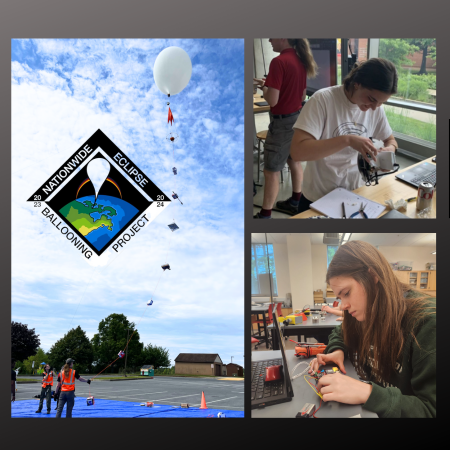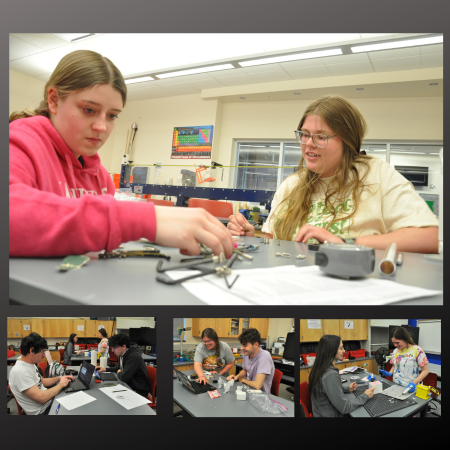Saint Francis joins Nationwide Eclipse Ballooning Project with NASA

Right Top: Abby Meehan (General Engineering) tests the PTERODACTYL she recently assembled. This flight computer logs measurements of position and orientation as well as air temperature and pressure throughout the balloon's flight that are critical to understanding the trajectory and behavior of the balloon. This is also the first of the team's payloads to have made it into the air, reaching an altitude of 81,283 ft during its maiden voyage.
Right Bottom: Olivia Baldini (General Engineering) troubleshoots the team's livestreaming video payload. This payload utilizes a pair of wide-angle cameras and a 5.8 GHz radio transmitter to stream a 360-degree view of the balloon's surroundings to a ground station (not pictured) assembled and tested by Nathan Cammarata (General Engineering).
The Nationwide Eclipse Ballooning Project (NEPB)
Earlier this year, Saint Francis University officially joined the Nationwide Eclipse Ballooning Project (NEPB) with NASA. As part of the NEBP's Engineering track, Saint Francis will loft a balloon into the atmosphere during both the annular eclipse in October 2023 and the total eclipse in April 2024. Each balloon will carry 12 pounds of payloads, including equipment to explore phenomena such as cosmic radiation, atmospheric gravity waves, or new technologies—all while live streaming a 360-degree bird's eye view of the Earth!
Saint Francis' Role and Reason
Sending 12 pounds of payload 70,000 feet into Earth's atmosphere is not a simple task, but it is a huge opportunity. The Saint Francis team, one of over 40 teams nationwide, will troubleshoot and build each payload to launch with their weather balloon during both eclipses.
The first solar eclipse will take place on Oct. 14, 2023, and the second—a total solar eclipse—will occur on April 8, 2024. The annular eclipse, which will appear first, happens when the Moon is at or near its farthest point from Earth. As a result, it is smaller and unable to block the Sun entirely.
Saint Francis is thrilled to be a part of this nationwide project and is fully embracing the opportunities emerging from it, especially the opportunity to give its students, from freshman to seniors, the opportunity to execute a large-scale, multidisciplinary engineering design project. While a typical classroom project involves smaller team, the launches require for NEBP will require more than 7 independent projects ranging from command and control to telemetry and ground support equipment: each of which requires its own project team to complete. This also requires the oversight of a Launch Director to ensure that all of the required systems-and-their personnel integrate smoothly.
Hugh Flanagan, a junior majoring in engineering with an aviation specialization, has taken the role of Launch Director for the summer launch campaign. He shares, "Joining the national eclipse ballooning project was an opportunity to join engineering and aviation through a topic in which I had no prior experience. As my last real opportunity to do research between years at SFU, I jumped on the chance to work with classmates in various academic years and of assorted backgrounds, and I look forward to where it takes the group of us professionally and personally."
One exciting aspect of the project is the opportunity not just to interact with a near-space vehicle, but also to design, build, and test elements of it. Olivia Baldwin, a sophomore engineering major and a player on SFU's Women's Lacrosse team, shares, "I decided to join the NEBP project because I saw it as an opportunity to improve my engineering skills outside of a classroom, and the fact that it's a NASA project is a plus. I'm extremely excited to start our work over the summer with the great team we recruited." Olivia also is excited to learn more about (and, hopefully, launch) CubeSats, and looks forward to flying a CubeSat testbed this coming year. Her teammates, Anna Belle Stover and Kevin Salmon (also a sophomore in General Engineering) have been hard at work designing and manufacturing the CubeSat's frame as well as its payload as the team begins its summer launch campaign.
Saint Francis General Engineering
Saint Francis' General Engineering program comprises six design courses, half of which occur in the program's first two years. Stratospheric ballooning offers this audience a substantial, exciting, and scientifically interesting set of engineering projects.
Students were recruited across academic years and backgrounds to form the team working on this national project. While recruiting the team, the University's mission was placed at the forefront. Whereas women make up less than 20 percent of the nation's engineering graduates, the University's General Engineering program is 36 percent women—and the program's first graduate was a woman. The proportion of women in General Engineering has been growing since 2020, as has the international diversity of the program.
Follow the SFU NEBP team's progress on the Engineering Facebook Page.

Bottom Row: Scott Castle (Computer Science) and Stephen McGinnis (Engineering) work on designs for a thermal-vacuum testing chamber while Megan Wheeler (Chemistry) and Abby Meehan (Engineering) work on payload box construction. The thermal-vacuum chamber will be used for the team's custom payloads, especially as they start the development of CubeSats that will be test-flown via balloon. Nicole Himes and Nathan Cammarata (Engineering) are assembling components of the team's antenna tracker, ensuring that the ground station remains in real-time communication with the balloon.
About the NEBP
Over 40 schools nationwide are working together with one mission: send balloons to the atmosphere during two solar eclipses to gather data. Combining atmospheric science and engineering, the project brings different backgrounds together for the greater good.
Since its inception in 2014, NEBP has supported studies during several eclipses—2017, 2019, and 2020. The project, led by the Montana Space Grant Consortium, is primarily funded through the Science Activation (SciAct) program within NASA's Science Mission Directorate (SMD).
NASA's SMD focuses on expanding knowledge in Earth science, planetary science, heliophysics, and biological and physical sciences. Through SciAct, SMD provides authentic opportunities for students to engage in these topics and more.
Contributions from the National Space Grant College and Fellowship Project (NASA Space Grant) and support from NASA's Balloon Program Office—based out of the agency's Wallops Flight Facility—also sponsor this project.
NASA Space Grant encompasses a national network of higher education institutions and partners. Space Grant's 52 consortia include one in each U.S. state, the District of Columbia, and the Commonwealth of Puerto Rico.
About Engineering at SFU
The General Engineering major is a distinctive choice for the entering freshman engineering student who desires a broad, thorough exposure to experimental design, problem-solving, teamwork, science, programming, and math. The ability to select an area of concentrated study within the degree provides great flexibility to pursue your career goals. Areas of study include aeronautics, computational modeling, innovation & entrepreneurship, mechanical engineering and robotics. Learn more about the B.S. in General Engineering at SFU.